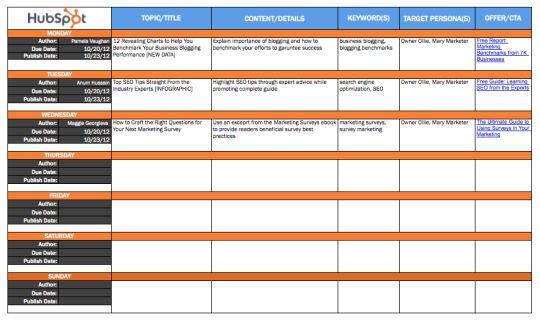
You’ve bought into content marketing as the path toward marketing dominion for your company. You’ve drafted a plan and are ready to rock. But before you start on that, you have a tradeshow exhibit to plan, a brochure to update, and a press release to put together about a new partnership. There are simply not enough hours in the day!
I’ve been there! It can be daunting, especially with so many other things on your plate. So here I’ve put together seven time-saving tips for when you are embarking on the journey we call content marketing.
1. Get buy-in up front
Perhaps this one is a no-brainer, but I really wish I’d known it when implementing just a simple blog at my company five years ago. I was given the task of starting a blog and went off with fervor on getting it up and running. While people at the company were excited to write at first, within six months, getting blog posts was like pulling teeth.
Content marketing requires a commitment to – guess what – creating content. Which means there will be writing. A lot of it. You’re going to need buy-in from the top down to make it happen, especially if you want to tap the expertise of thought leaders in your company. Otherwise, plan on either 1) writing everything yourself or 2) lots of babysitting, nagging, and missed deadlines (i.e. a time hole sink).
Save yourself the hassle and get commitment from the CEO/President and make sure that commitment is communicated over and over again to the people you’ll need content from. If you can finagle rewards (gift cards for people who go above and beyond, for example) and/or consequences (getting a stern email from the CEO, perhaps) up front, that will also save time later. Future hires should also be told during the interview process that x amount of their time will be spent writing content for marketing so their expectations are set at the beginning.
2. Have a calendar & plan promotion and follow-up

You have a plan to write about x, y, and z, but putting it into a calendar with dates, who’s responsible, persona(s) targeted, and conversion paths, etc. will make it infinitely easier to track and help you stay organized. Check out these resources: A Content Marketer’s Checklist: Editorial Calendar Essentials and HubSpot’s Blog Editorial Template (at right), which can be modified to organize all of your content.
And while we’re on the topic of planning, don’t forget that writing the content is only a piece of the pie. Setting up an inbound campaign includes promoting the content and defining what the next step in the process is. In terms of promotion, make sure you know how and when you’ll get the word out about your new piece. Also make sure you’ve developed what the call-to-action is after someone reads your blog post or downloads a white paper (as well as what nurturing emails he or she will get!). What’s the next step? You don’t want to be scrambling to figure it out after the fact.
3. Don’t stay stuck
When creating your calendar and scheduling content, don’t let yourself get stuck (or rather, stay stuck) when you can’t think of new things to produce. Staying stuck will stall your program and hinder your marketing efforts. Here are some ways to get fresh ideas:
- Get your marketing team and company’s thought leaders (otherwise known as people who help write content at your company) together in a room and brainstorm.
- Ask your salespeople what sort of questions leads have about your product or the industry. Ask your customer support team what sort of questions customers have. Ask your head product guy what features are coming down the pipeline.
- Use some content creation templates, such as those offered by HubSpot. Maybe it’s time for a content curation blog post or an ebook on the top 10 trends in your industry. A template will help get you started.
- Repurpose content and rethink content by expanding your current view. As you are creating new content, think about other ways it could be used, such as a blog post being turned into an infographic. (And then an infographic being turned into micrographics for social media posts.) Or taking a webinar recording and turning a section of it into a podcast. Or taking a case study and turning it into a Q&A blog post. Repurposing content in this way will save you loads of time. (My favorite term for this is “turkey slices” – thank you Jason Miller and Rebecca Lieb.)
- Try a tool such as HubSpot’s Blog Topic Generator or Portent’s Content Idea Generator. Either tool will get you unstuck lickety-split.
- Bonus: Check out more ideas in this SmartBug Media blog post: 7 Ways to Find Topic Ideas.

And finally, make sure you have a backlog of content (blog posts, especially, given their frequency) for when you do get stuck. Then you won’t panic when a content block hits you.
4. Define processes
Speaking of organization, define your company’s processes before you write your first piece of content. (Again, this will save time in the long run.)
For example, does everyone on the editorial committee review every blog post? Does the CEO have to sign off before an ebook is published? Do people collaborate on Google Drive or do they email a Word document back and forth? How many days do people need to write something? To edit something? To sign off? What happens when someone misses a deadline? How long will it be between when something is finished and when it’s published publicly?
Setting expectations up front for you and your team will be immensely helpful.
5. Pick the right tools
I mentioned the first blog I set up five years ago; we downloaded WordPress for free and had our IT team install it on our own server. Free is good, right? Well, only if you have gobs of time to spare. I spent two weeks trying to get that blog to look like I wanted it to. (PHP isn’t my strong suit.) Save yourself the time: find a template you like, buy it, and then work from there. Better yet, find a freelancer in your area who can do it for you. The small cost is worth the hassle.
However, if you want to think beyond just a blog, don’t go with the WordPress route. A content marketing plan is much more than a blog, and you want to think of the big picture, which in addition to blogging, includes calls-to-action, landing pages, premium content, forms, email, SEO, social media, and more. (Plus the ability to analyze the performance of different pieces of content and channels.) Trust me, WordPress isn’t going to cut it for a true inbound content strategy – you’ll need a marketing automation system.
SmartBug recently completed an in-depth review of HubSpot, Marketo, and Pardot. Choose your tool wisely; because once you invest in a marketing automation system, you’ll want to get the most out of it and probably won’t want to switch any time soon.
6. Analyze to figure out what’s working and what’s not

You’ll see this on the SmartBug Media blog over and over again: analyze your results. Without looking into what works and what doesn’t, you’ll waste your time in the future creating content that is sub-optimal.
Based on your goals, review your content and look for trends. Did social media promotions drive traffic to a piece of content? Did a particular blog post convert well? Did a landing page have a high abandonment rate? Did one topic get a high number of likes/shares/comments and another not? Did one conversion path really work in getting qualified leads?
Once you have some answers as to what’s working, implement a strategy that resonates with your marketplace and save yourself the time of putting out the stuff that doesn’t.
7. Enlist help (when needed)
Ideas 1-6 will help you save time in implementing your content marketing strategy, but it will still take a LOT of time. (Inbound marketing is not a quick fix; it’s a way of life.) If you already have a ton of stuff going on in marketing, with no expectation of any of it going away any time soon, you may want to enlist help.
An inbound marketing agency, such as SmartBug Media, can help you implement a content marketing strategy in a fraction of the time it would take you to do it all yourself.
There you have it: seven time-saving tips for launching your company’s marketing content program into the stratosphere. Looking back over the list, I realize a lot of them are just best practices. Perhaps best practices = time saved from not doing it the hard way.
Good luck!
This article was syndicated from Business 2 Community: 7 Time-Saving Tips When Implementing a Content Marketing Plan
More Sales & Marketing articles from Business 2 Community:




